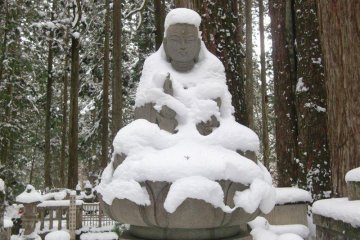If there is a place in Japan where spirituality and natural beauty intertwine in a sublime way, it is Koya San, founded in the 9th century by the monk Kukai, also known as Kobo Daishi. Here, amidst the mist and ancient cedars, time seems to have stopped; peace and tranquility reign supreme.
My journey begins in Osaka, where, through an Italian agency called LE GRU TRAVELS, which organized everything perfectly (transportation, accommodation, etc.), we headed towards Koya San. Located in Wakayama Prefecture, it is about a two-hour train ride from Osaka.
KONGOBU-JI TEMPLE
The first stop of the day was the visit to Kongobu-ji Temple, recognized as a national heritage treasure. Built during the Edo period by Toyotomi Hideyoshi to commemorate his mother’s death, it later became the main headquarters of the Shingon Buddhism founded by Kobo Daishi. This sacred site consists of numerous structures nestled within lush vegetation, many of which are open to visitors.
STAYING IN A MONASTERY
After a brief stop for lunch, we made our way to our shukubo (a Buddhist monastery that offers hospitality to visitors). Upon arrival, each guest is warmly welcomed by the monks, dressed in traditional robes. The simple yet inviting room is furnished in traditional Japanese style, with tatami mats and futons prepared for the night. Dinner is an experience in itself: a vegetarian menu is served, prepared according to the principles of Buddhist cuisine. Every dish is a work of art, featuring fresh, seasonal ingredients that reflect the harmony of nature.
THE LARGEST CEMETERY IN JAPAN
Okunoin: this extensive area of the temple is home to the largest cemetery in Japan, with tombstones and monuments for over 200,000 graves, including those of some of the most famous figures in Japanese history. All these souls seek to approach Kukai in hopes of finding the path to salvation. The Ichi-no-hashi bridge marks the entrance to the temple and connects the sacred world with the secular one. Visitors must bow to show respect to Kukai before crossing the bridge and entering Okunoin. At the end of the path, one finds the Torodo Hall, also known as the Lantern Hall. In front of it is the mausoleum of Kobo Daishi; entry is prohibited as it is believed that the monk is in a continuous state of meditation and should not be disturbed.
CONCLUSIONS
As we conclude this experience, we can only be enchanted by this journey rich in traditions, customs, and flavors, where the slow rhythms and the scent of incense accompanied us during our visit a dream so unreal yet so strong that it captures the heart…









